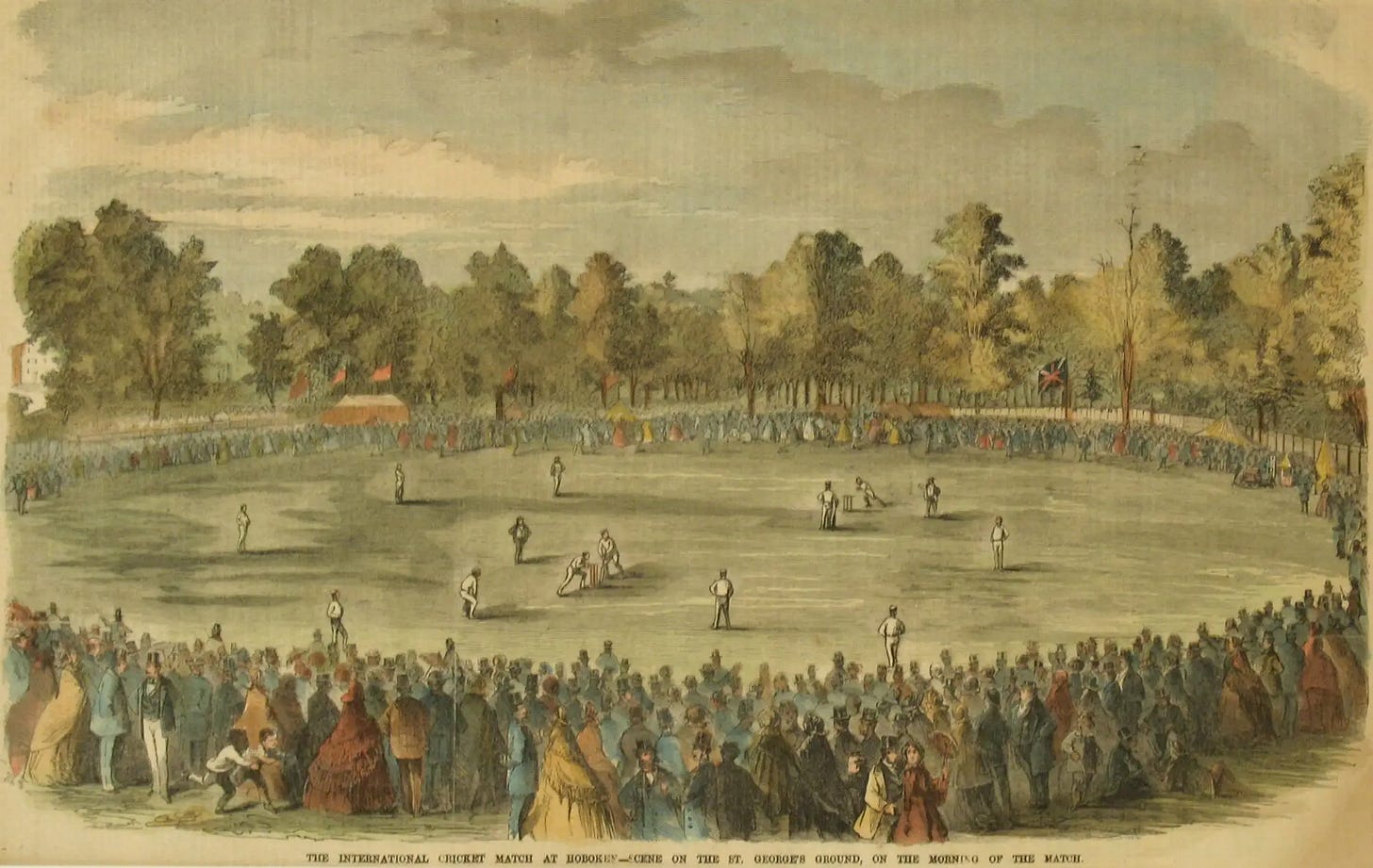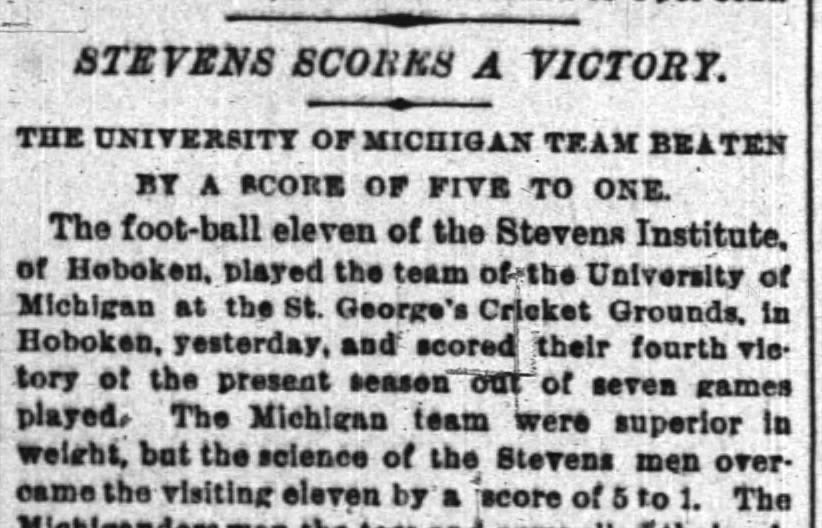1883 Michigan-Stevens Institute Game
Michigan's 1883 team was the only non-Eastern team playing football at their level. This series uses period publications to cover Michigan's trip east to play Wesleyan, Yale, Harvard, and the Stevens Institute in nine days.
Previous posts in the series: Intro | Wesleyan | Yale | Harvard
Everyone agrees that after Michigan lost to Wesleyan, Yale, and Harvard during their 1883 trip east, they faced Stevens Institute on a Tuesday afternoon at the hallowed St. George's Cricket Grounds in Hoboken, New Jersey. Other than the fact that the game occurred, there is little agreement about what happened during the game, at least those of the closing minutes.
Although Stevens Institute is seldom mentioned as a college football power, it was once one of college football's top five teams, largely because it was the fifth school to play the game, following Princeton, Rutgers, Harvard, and Yale. Of course, the version it originally played was the hacky-sack version.
Like other schools, they switched to rugby football after 1876 and were reasonably competitive, struggling with the likes of Harvard, Princeton, and Yale, while their 1883 team beat Columbia and Lafayette before tying Penn.
Their home field was the St. George's Cricket Grounds in Hoboken, the scene of many top matches, so Michigan was thrilled to play there and compete in a game they might win.

Michigan was the heavier team that day, but being Midwesterners, they were less practiced in the football arts and were unaccustomed to the rule changes made just before starting their four-game road trip.
Michigan won the toss and forced Stevens to play into the heavy wind during the first inning, a strategy that proved effective since the wind died down at halftime. Most of the first half was played in Stevens’ territory, with Michigan forcing Stevens to take a safety touchdown to take a 1-0 lead. Later in the first inning, Stevens moved deep into Michigan territory and kicked a goal from field for a 5-1 lead.
The second half was mostly played on Michigan’s side of the field, with neither team scoring until late, or neither team scoring, depending on who you believe. The New York Times and the Stevens Institute fans report the final score at 5-1 in Stevens' favor, but the Michigan folks dispute that score.
Before describing what happened at the end of the game, I will note that both sides complained that Mr. Hildreth, the referee, did not know what he was doing. Football was still new, and the rules had changed in recent weeks, so Mr. Hildreth regularly stopped play during the game to consult the rule book. Of course, we don't know if he had an old or current version of the rules.
As the game neared its end, Moore for Michigan, had a long run for a touchdown, a point Stevens did not dispute. However, they claimed it had become so dark that the Stevens players did not pursue Moore, believing the game was over. The accounts also suggest that Mr. Hildreth went back and forth on how he ruled on Moore’s run.
In 1883, a touchdown was worth 2 points and a goal from field was worth 5, so if you count Moore's touchdown run, the score stood 5-3 in favor of the Stevens Institute, after which Michigan executed a puntout. However, when a team caught a puntout, they could run the ball back, score a touchdown, and attempt another puntout, earning 2 points each time.
Since the Stevens Institute team did not acknowledge Moore’s touchdown run, they also did not contest Michigan’s first puntout, or the second one they ran back for a touchdown, or the third, and so on, as Michigan scored eight touchdowns at the game’s end, making the final score 17 to 5.
Today, Michigan recognizes the 17-5 score while the Stevens Institute says the score was disputed, but defers to the New York Times report as an independent source, though a Steven-affiliated correspondent likely wrote the Times story.
So, that's how Michigan's second trip east ended. They were back in Ann Arbor by Thursday, carrying a 1-3 or 0-4 record, depending on who you believe.
Although I have not mentioned the Stevens Institute in the series on schools that deemphasized football, they may have been the first school to do so since they chose in 1892 to avoid the big boys and play a mix of varsity and club teams before dropping the sport entirely in 1925.
Michigan went on to become the winningest team in college football history, though the win total they claim (1,012 as of this date) is open to interpretation based on your view of the 1883 Stevens Institute game, the 1892 Oberlin game, and, perhaps, others.
I'll leave it to others to figure out.
Click here for options on how to support this site beyond a free subscription.



I contacted Stevens about football sources. I was told that their sports historian lived in the cave with bones out in front ..
"As the game neared its end, Moore for Michigan, had a long run for a touchdown, a point Stevens did not dispute. However, they claimed it had become so dark that the Stevens players did not pursue Moore, believing the game was over.
"Since the Stevens Institute team did not acknowledge Moore’s touchdown run, they also did not contest Michigan’s first puntout, or the second one they ran back for a touchdown, or the third, and so on, as Michigan scored eight touchdowns at the game’s end, making the final score 17 to 5."
Michigan Football: Cheating for 140+ Years (lol :) )